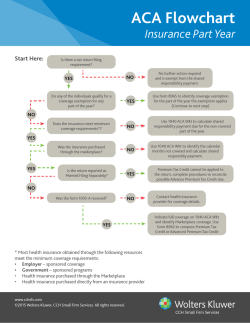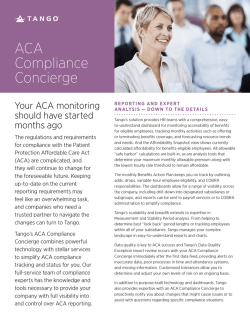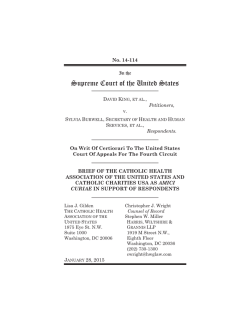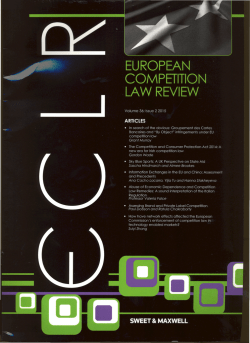
In The - PremiumTaxCredits
No. 14-114 In The DAVID KING, ET AL., v. Petitioners, SYLVIA BURWELL, SECRETARY OF HEALTH AND HUMAN SERVICES, ET AL., Respondents. On Writ of Certiorari to the United States Court of Appeals for the Fourth Circuit BRIEF OF THE SMALL BUSINESS MAJORITY FOUNDATION, INC. AND PEERS AS AMICI CURIAE IN SUPPORT OF RESPONDENTS Pratik A. Shah Counsel of Record Hyland Hunt Z.W. Julius Chen John B. Capehart AKIN GUMP STRAUSS HAUER & FELD LLP 1333 New Hampshire Ave., N.W. Washington, D.C. 20036 (202) 887-4000 [email protected] QUESTION PRESENTED Whether the Treasury Department permissibly interprets 26 U.S.C. § 36B to make the Affordable Care Act’s federal premium tax credits available to eligible taxpayers through the Exchanges in every State. (i) ii TABLE OF CONTENTS QUESTION PRESENTED ........................................... i INTEREST OF AMICI CURIAE ................................ 1 INTRODUCTION AND SUMMARY OF THE ARGUMENT .......................................................... 3 ARGUMENT ................................................................ 5 I. EXCHANGE TAX-CREDIT SUBSIDIES PLAY AN ESSENTIAL ROLE IN MITIGATING JOB LOCK ..................................... 5 A. Health Insurance Is A Key Component Of Economically Inefficient Job Lock.................... 5 B. Congress Has Taken Steps, Culminating In ACA, To Reduce Job Lock ............................ 9 C. ACA Tax-Credit Subsidies Have Mitigated Job Lock And Enabled Greater Choice In Employment And Entrepreneurship ............. 11 II. THE EXCHANGES HELP SMALL BUSINESSES ADDRESS HEALTH CARE COSTS .................................................................. 15 CONCLUSION .......................................................... 20 iii TABLE OF AUTHORITIES CASE: Geissal v. Moore Med. Group, 54 U.S. 74 (1998) .................................................... 9 STATUTES AND REGULATION: 42 U.S.C. § 18091(2)(I) .............................................. 17 Consolidated Omnibus Budget Reconciliation Act, Pub. L. No. 99-272, 100 Stat. 82 (1986) ......... 9 Health Insurance Portability and Accountability Act of 1996, Pub. L. No. 104191, 110 Stat. 1936............................................... 10 Patient Protection and Affordable Care Act, Pub. L. No. 111-148, 124 Stat. 119 (2010)............. 2 79 Fed. Reg. 30,240 (May 27, 2014) .......................... 19 OTHER AUTHORITIES: Boothe, Angela, American Action Forum, Primer: The Small Business Health Options Program (SHOP) (Oct. 21, 2014) ......................... 19 Buchmueller, Thomas C., National Bureau of Economic Research, Consumer Demand for Health Insurance (2006) ................................ 18, 19 iv Centers for Medicare & Medicaid Services, Small Business Health Options Program (SHOP), http://www.cms.gov/CCIIO/ Programs-and-Initiatives/HealthInsurance-Marketplaces/2015-Transitionto-Employee-Choice-.html.................................... 19 Congressional Budget Office, Economic and Budget Issue Brief, Effects of Changes to the Health Insurance System on Labor Markets (2009) .................................................... 5, 6 Congressional Budget Office, Key Issues in Analyzing Major Health Insurance Proposals (2008) ..................................................... 7 Congressional Budget Office, The Budget and Economic Outlook: 2014 to 2024 (2014) .............. 11 Corporation for Enterprise Development, Microbusinesses: America’s Unsung Entrepreneurs (May 2013) .................................. 13 Craig, William, Four Reasons the Affordable Care Act is a Boon to Entrepreneurs, FORBES, June 17, 2014 ..................................... 7, 18 Dewan, Shaila, Unfettered Capitalism, N.Y. TIMES, Feb. 23, 2014 ............................................ 13 Dizioli, Allan & Roberto Pinheiro, Health Insurance as a Productive Factor (2012) ............. 16 v Employee Benefit Research Institute, Sources of Health Insurance and Characteristics of the Uninsured: Analysis of the March 2008 Current Population Survey (Sept. 2008) ....... 6, 7, 8 Gabel, Jon, et al., Generosity and Adjusted Premiums in Job-Based Insurance: Hawaii is Up, Wyoming is Down, 25 HEALTH AFFAIRS 832 (2006) ............................................... 15 Garthwaite, Craig, et al., Public Health Insurance, Labor Supply, and Employment Lock, 129 Q.J. OF ECON. 653 (2014) ..................... 11 Geron, Tomio, Airbnb And The Unstoppable Rise Of The Share Economy, FORBES, Jan. 23, 2013................................................................. 14 Gruber, Jonathan & Brigette C. Madrian, Health Insurance and Job Mobility: The Effects of Public Policy on Job-Lock, 48 INDUS. & LAB. REL. REV. 86 (1994) .................. 9, 10 Health and Disability Advocates, Chicago Area Small Businesses and the Affordable Care Act (2014) .............................................................. 16 Hyman, David A. & Mark Hall, Two Cheers For Employment-Based Health Insurance, 2 YALE J. HEALTH POL’Y L. & ETHICS 23 ................... 5 Jorgensen, Helen & Dean Baker, Center for Economic and Policy Research, The Affordable Care Act: A Family-Friendly Policy (2014) ................................................... 14, 15 vi Luque, Adela et al., The Effect of Employer Health Insurance Offering on the Growth and Survival of Small Business, Upjohn Institute Technical Report No. 13-030 (2013) .................................................................... 16 Madrian, Brigette C., Employment-Based Health Insurance and Job Mobility: Is There Evidence of Job Lock?, 109 Q.J. of ECON. 27 (1994) .............................................passim Monahan, Amy B., et al., Saving SmallEmployer Health Insurance, 98 IOWA L. REV. 1935 (2013)................................................... 15 O’Neill, Stephanie, Some Obamacare Enrollees Emboldened to Leave Jobs, Start Businesses, KAISER HEALTH NEWS, Apr. 29, 2014................................................................. 12, 15 Press Release, Statement of U.S. Commerce Secretary Penny Pritzker on the Affordable Care Act Open Enrollment (Nov. 15, 2014) ........ 13 Small Business Majority Foundation, Inc., et al., Opinion Poll: The Role of Micro Businesses in Our Economy (2012) ...................... 13 Small Business Majority Foundation, Inc., What’s In Healthcare Reform for Small Businesses? (2011) ................................................ 17 Spragins, Ellyn E., How to Beat Job Lock, NEWSWEEK, Dec. 14, 1998 ...................................... 8 vii U. S. Census Bureau, Statistics About Business Size (Including Small Businesses), http://www.census.gov/econ/smallbus.html ......... 7 U.S. Government Accountability Office, Health Care Coverage: Job Lock and the Potential Impact of the Patient Protection and Affordable Care Act (2011) ............................passim In The No. 14-114 DAVID KING, ET AL., v. Petitioners, SYLVIA BURWELL, SECRETARY OF HEALTH AND HUMAN SERVICES, ET AL., Respondents. On Writ of Certiorari to the United States Court of Appeals for the Fourth Circuit BRIEF OF THE SMALL BUSINESS MAJORITY FOUNDATION, INC. AND PEERS AS AMICI CURIAE IN SUPPORT OF RESPONDENTS INTEREST OF AMICI CURIAE 1 The Small Business Majority Foundation, Inc. is a national, nonpartisan organization founded and run by small business owners across the United States. The Foundation researches policy proposals This brief is filed with the written consent of all parties through universal letters of consent on file with the Clerk. No counsel for either party authored this brief in whole or in part, and no person or entity other than the amici, their members, or their counsel made a monetary contribution to the brief’s preparation or submission. 1 (1) 2 that address small business needs, create jobs, and maximize business opportunities and competitiveness for small businesses across the United States. The Foundation also represents the interests of small businesses before Congress and state legislatures, the Executive Branch, and the courts (including this Court). In recent years, it has focused on policies that address health care costs, which limit workforce mobility and disproportionately burden small businesses. See, e.g., Br. of Small Business Majority Foundation, Inc., et al., Department of Health and Human Services, et al. v. Florida, No. 11-398. The Foundation believes that the insurance “Exchanges” created by the Patient Protection and Affordable Care Act, Pub. L. No. 111-148, 124 Stat. 119 (2010) (ACA or the Act), by providing a means of acquiring affordable health insurance, play a critical role in mitigating these burdens for employees, small businesses, and the self-employed. Peers is the world’s largest independent sharingeconomy community, whose mission is to make the sharing economy work for the people who power it by supporting the workers of the sharing economy. The sharing economy allows individual microentrepreneurs to develop self-employed careers around their unique talents and interests. Peers wants to make the sharing economy a more attractive work opportunity to individuals by making it easier to find, compare, and manage work outside of a traditional employment environment, and believes that enhancing the availability of affordable health insurance not tethered to conventional employersponsored health plains is vital to the sharing economy’s success. 3 Amici and their members therefore have a substantial interest in the proper resolution of the question presented in this case. INTRODUCTION AND SUMMARY OF THE ARGUMENT In the United States, employment and access to affordable health insurance historically have been tightly linked. That linkage pressures individuals to seek out and remain in jobs that provide affordable health insurance, even if they would otherwise choose to start their own business or pursue a more attractive job opportunity with a growing small business. This phenomenon is known as “job lock.” Reforms like ACA’s Exchanges and tax-credit subsidies, which enable access to affordable health insurance irrespective of employment, go a long way toward mitigating job lock and freeing individuals to make life choices about employment, entrepreneurship, and family care without forgoing affordable health care. Amici agree with the Solicitor General that Congress authorized federal tax-credit subsidies for health insurance purchased on an Exchange both in States that established an Exchange for themselves and in States that were unable to do so or opted to allow the Department of Health and Human Services to establish an Exchange in their stead. That result is consistent with Congress’s long-running efforts to eliminate the constraints that employer-sponsored health insurance places on job mobility and employee flexibility. ACA’s Exchanges and tax credits represent Congress’s latest—and most fulsome—step in efforts to expand access to health insurance and to 4 combat job lock by decoupling access to affordable health insurance from employment. Although operative for only one full year, those reforms already have provided individuals with the freedom to become entrepreneurs, start or work for small businesses, and pursue other endeavors. ACA’s reforms, moreover, have benefitted small businesses, which had faced disproportionate costs in obtaining insurance coverage for their employees. By providing small-business employees and entrepreneurs the opportunity to obtain affordable coverage on the Exchanges directly, with the favorable tax treatment that employer-sponsored coverage has long received, the Exchanges improve small-business competitiveness. In addition, the Exchanges make it possible—through the Small Business Health Options Program (SHOP)—for small businesses to obtain comprehensive health care coverage for their employees at lower costs and with greater price stability than ever before. The tax credits authorized by Congress for the Exchanges thus make it possible for both individuals and small businesses to make choices regarding the investment of their labor and resources that allow them to realize their full potential, to the benefit of those individuals and businesses as well as the national economy. 5 ARGUMENT I. EXCHANGE TAX-CREDIT SUBSIDIES PLAY AN ESSENTIAL ROLE IN MITIGATING JOB LOCK A. Health Insurance Is A Key Component Of Economically Inefficient Job Lock Employer-sponsored health insurance—first offered as an employee benefit in the 1930s—has been an economic fixture in the United States since World War II. See David A. Hyman & Mark Hall, Two Cheers For Employment-Based Health Insurance, 2 YALE J. HEALTH POL’Y L. & ETHICS 23, 25-26 (2001) (describing rise of employment-based coverage “fueled by federal labor and tax policy” and labor unions). Not only do “[a] majority of Americans rely on private insurance for health coverage,” U.S. Government Accountability Office, GAO-12-166R, Health Care Coverage: Job Lock and the Potential Impact of the Patient Protection and Affordable Care Act 3 (2011) (hereinafter “GAO Report”), but “[t]he majority of privately insured Americans obtain their health insurance through their own or a family member’s employment,” Brigette C. Madrian, Employment-Based Health Insurance and Job Mobility: Is There Evidence of Job Lock?, 109 Q.J. OF ECON. 27, 27 (1994). That “close linkage” between health insurance and employment “affect[s] people’s decisions to enter the labor force, to work fewer or more hours, to retire, and even to work in one particular job or another.” Congressional Budget Office, Economic and Budget Issue Brief, Effects of Changes to the Health 6 Insurance System on Labor Markets 1 (2009) (hereinafter “CBO Report”); see GAO Report 3 (same). When employees “stay[] in jobs they might otherwise leave for fear of losing access to affordable health coverage”—whether because insurance is more expensive at the prospective job, does not cover a preexisting condition, or is not offered at all—economists refer to that phenomenon as “job lock.” GAO Report at 3. Health care-induced job lock has disproportionately hindered the development of small businesses and entrepreneurship, because it has historically limited the freedom of individuals to capitalize on an idea for a new business when that meant leaving employment that provided health coverage. Because both the self-employed and small businesses with few employees lack the ability to spread risk among large numbers of people, they have faced particular challenges in procuring affordable health coverage. Prior to the Act, self-employed Americans were nearly twice as likely to be uninsured than workers in very large businesses. Employee Benefit Research Institute, Sources of Health Insurance and Characteristics of the Uninsured: Analysis of the March 2008 Current Population Survey 12 (Sept. 2008). Small businesses were “less likely to offer their employees health coverage, citing the cost of coverage as a key reason.” GAO Report at 3. And when small businesses did offer insurance, their employees paid “nearly 30 percent” of “the average share of *** policy premiums,” as compared to employees of larger firms who pay “about 7 percent.” CBO Report at 1 n.1; see Madrian, 109 Q.J. OF ECON. at 29 (“For small employers, one major illness may 7 significantly increase the firm’s premiums for several years.”). As a result, for the 22 million self-employed Americans and some employees of the country’s 5.8 million small businesses, coverage options were both limited and undesirable before ACA’s reforms. 2 These individuals could either: (i) purchase health insurance in the individual market, paying a fullfreight premium without either an employer subsidy of “more than 70 percent on average,” GAO Report at 3-4, or the favorable tax treatment long granted employer-sponsored coverage; 3 or (ii) forgo healthinsurance coverage altogether, see William Craig, Four Reasons the Affordable Care Act is a Boon to Entrepreneurs, FORBES, June 17, 2014 (citing Gallup study showing that “one in four entrepreneurs went without health insurance in 2012”). 4 Reflecting these limited options, of the 45 million Americans without health insurance in 2007, nearly 23 million were small business owners, employees, or their dependents. See Employee Benefit Research See U. S. Census Bureau, Statistics About Business Size (Including Small Businesses), http://www.census.gov/econ/ smallbus.html (last visited Jan. 27, 2015). 3 Prior to the Act, health insurance purchased in the individual market generally did not receive favorable tax treatment. Congressional Budget Office (CBO), Key Issues in Analyzing Major Health Insurance Proposals 9 (2008). The federal tax subsidy for employment-based health coverage in 2007 was $246 billion. Id. at 31. 4 Available at http://www.forbes.com/sites/groupthink/2014/06/ 17/four-reasons-the-affordable-care-act-is-a-boon-toentrepreneurs/. 2 8 Institute, supra. That reality contributed significantly to job lock and thereby deterred otherwise interested and talented individuals from striking out on their own to become self-employed entrepreneurs or from joining smaller businesses that would be unable to offer comparable insurance coverage. As a result of the dearth of affordable options outside of large-employer coverage, job lock has had substantial consequences for a considerable number of people. Nearly one-third of respondents in a research survey had been affected by job lock, with a 25% reduction in job mobility and in individuals’ freedom to choose among potential employment options, including starting a new business. See Madrian, 109 Q.J. OF ECON. at 28-29, 52 (citing poll and conducting statistical analysis). Given the economic toll job lock exacts, it unsurprisingly is “[b]y definition” a “negative phenomenon.” GAO Report at 3. As one commentator put it: There’s no shortage of sad stories about health insurance. But for pure frustration, nothing beats job lock: being frozen in a job you hate because leaving it means losing key health benefits. You’re stuck because you have a bad knee, your daughter has diabetes or your wife has emphysema. No new insurer wants your family unless it can draw a big red circle around your maladies and refuse to cover everything inside. Ellyn E. Spragins, How to Beat Job Lock, NEWSWEEK, Dec. 14, 1998, at 98. 9 Taken in the aggregate, the distorting effects of job lock are equally undesirable. “[I]f individuals who would like to move to more productive jobs are constrained to keep their current positions simply to maintain their health insurance,” that causes “[t]he productivity of the economy as a whole [to] suffer.” Madrian, 109 Q.J. OF ECON. at 28. Concomitantly, “[e]conomic theory generally suggests that worker mobility *** enables workers to obtain employment”—including through self-employment and starting a new business—“where they are most productive, which in turn promotes efficiencies in the labor market and provides benefits to the overall economy.” GAO Report at 3. B. Congress Has Taken Steps, Culminating In ACA, To Reduce Job Lock Congress has long been concerned with the negative effects of job lock on individual choice and the national economy, and its efforts to combat the problem extend back nearly thirty years. In 1986, Congress enacted the Consolidated Omnibus Budget Reconciliation Act, Pub. L. No. 99272, 100 Stat. 82, which (among other provisions) gave qualified employees the “opportunity to elect ‘continuation coverage’” under an employersponsored group health plan “when the beneficiaries might otherwise lose coverage upon *** the termination of the covered employee’s employment.” Geissal v. Moore Med. Group, 524 U.S. 74, 79-80 (1998). An influential academic study concluded that so-called “COBRA” coverage “had some success in alleviating job lock” and “increase[ed] the insurance coverage of job leavers.” Jonathan Gruber & Brigette 10 C. Madrian, Health Insurance and Job Mobility: The Effects of Public Policy on Job-Lock, 48 INDUS. & LAB. REL. REV. 86, 100 (1994). As part of the major health-care reform of the 1990s, Congress took further steps to decouple the availability of affordable insurance from employment through the enactment of the Health Insurance Portability and Accountability Act of 1996, Pub. L. No. 104-191, 110 Stat. 1936. This Act “set new minimum standards for portability of health coverage and may have increased workers’ willingness to change jobs by prohibiting employers from excluding eligible employees from participation in the health plan and by restricting the ability to impose waiting periods for coverage of preexisting health conditions.” GAO Report at 8. Although important, these enacted reforms did not eliminate the constraints of employer-sponsored health insurance. See Gruber & Madrian, 48 INDUS. & LAB. REL. REV. at 87 (recognizing that “‘continuation of coverage’ mandates” are a “partial corrective”). According to the U.S. Government Accountability Office (GAO), 29 of 31 studies on job lock published after 2000 “presented evidence consistent with job-lock,” GAO Report at 6, including four studies that examined the influence of employersponsored health insurance on the “decision to become self-employed,” id. at 15 (capitalization omitted). In enacting ACA in 2010, Congress once again took on the task of addressing job lock, among other goals, by increasing the accessibility and affordability of health care for all Americans. Based on interviews 11 with experts, the GAO forecasted “that to the extent [ACA] expands access to health coverage for certain individuals, it may help mitigate job lock”—citing in particular “the establishment of Affordable Insurance Exchanges.” Id. at 9-10. C. ACA Tax-Credit Subsidies Have Mitigated Job Lock And Enabled Greater Choice In Employment And Entrepreneurship Because the Exchanges and the tax-credit subsidies authorized by ACA have been operative for only a single calendar year, experts have only recently begun quantifying the effect on job lock of these and other reforms. Still, the available data, coupled with ample anecdotal evidence, indicate that the Exchanges have meaningfully increased individual choice, job mobility, and flexibility. In February 2014, following the first annual period for enrollment in health insurance through the Exchanges, the CBO anticipated that over the next decade more than two million full-time-equivalent workers would make different employment choices than they would have in the absence of the Act. CBO, The Budget and Economic Outlook: 2014 to 2024, at 117 (2014). According to the CBO, “[t]he subsidies for health insurance purchased through exchanges” were the part of the ACA reform primarily responsible for that result. Id. at 118-119; accord Craig Garthwaite et al., Public Health Insurance, Labor Supply, and Employment Lock, 129 Q.J. OF ECON. 653, 691-692 (2014) (calculating a change in employment status for approximately 12 500,000 to 900,000 individuals “newly eligible for free or heavily subsidized health insurance”). The preliminary evidence indicates that those workers who are now freer to make employment choices without the burden of forgoing affordable health coverage are making a variety of choices bestsuited to their individual circumstances. Access to affordable subsidized health insurance through the Exchanges has often proven to be the difference for individuals looking to leave a job to create small businesses or to become self-employed. For example, Rebecca Murray found herself unable to leave her job at a dialysis company because she risked losing coverage for a $30,000 medication that treated her husband’s chronic spinal arthritis. Through the Exchange, however, she was able to purchase health insurance for her family at a subsidized cost of $535 per month, freeing her to start a company that helps other women care for their sick relatives. See Stephanie O’Neill, Some Obamacare Enrollees Emboldened to Leave Jobs, Start Businesses, KAISER HEALTH NEWS, Apr. 29, 2014. 5 Similarly, Russ and Linda Dickson recently opened a new retail business in Georgetown, Texas. Russ, nearing retirement age, had stayed in his longterm job to keep his health insurance. But with the opening of the Exchanges, the Dicksons were able to secure affordable coverage and fulfill a dream to Available at http://kaiserhealthnews.org/news/health-lawenrollees-emboldened-to-leave-jobs-start-businesses/. 5 13 strike out on their own. See Press Release, Statement of U.S. Commerce Secretary Penny Pritzker on the Affordable Care Act Open Enrollment (Nov. 15, 2014); cf. Shaila Dewan, Unfettered Capitalism, N.Y. TIMES, Feb. 23, 2014, at MM20 (Magazine) (recounting story of Lauren Braun, who, because she was able to stay on her parents’ insurance under ACA, left her job after receiving a $100,000 Bill and Melinda Gates Foundation grant to make and distribute silicone bracelets that remind mothers of upcoming vaccinations in Peru). As these examples indicate, the Exchanges have played a critical role in supporting the ever-growing role of microbusinesses, which include the selfemployed and businesses with four or fewer employees. These businesses play a critical role in the U.S. economy; the 22 million self-employed small business owners generate almost $1 trillion in economic activity each year. See Corporation for Enterprise Development, Microbusinesses: America’s Unsung Entrepreneurs 1 (May 2013). 6 In a recent survey, 74% of microbusiness owners reported that their businesses were their sole source of income, and more than half reported hiring an independent contractor in the past year. See Small Business Majority Foundation, Inc., et al., Opinion Poll: The Role of Micro Businesses in Our Economy 4 (2012). 7 Available at http://cfed.org/assets/pdfs/FactFile_May2013.pdf. Available at http://www.smallbusinessmajority.org/smallbusiness-research/downloads/100912-micro-business-report.pdf. 6 7 14 The explosive growth of the sharing economy in recent years has created even more opportunities for individuals to operate as microentrepreneurs by using new online marketplaces that make it easier to build an individual business and connect to customers. See Tomio Geron, Airbnb And The Unstoppable Rise Of The Share Economy, FORBES, Jan. 23, 2013 (describing the sharing economy as “an economic revolution that is quietly turning millions of people into part-time entrepreneurs”). With an estimated size of $3.5 billion in 2013 and a 25% growth rate, id., the sharing economy provides expanded opportunities to individuals to build flexible self-employed careers that suit their talents and interests. The availability of affordable health insurance outside of a traditional employment relationship is critical to the ability of individuals to seize these new economic opportunities. In addition, an early study suggests that ACA’s Exchanges are enabling families to make different choices regarding child care than they would have been able to make before the Act. See Helen Jorgensen & Dean Baker, Center for Economic and Policy Research, The Affordable Care Act: A FamilyFriendly Policy (2014). Based on data from the Current Population Survey, the study found that the “notable uptick in voluntary part-time employment in the first seven months that the exchanges have been in operation” was “consistent with the view that many workers are now able to work at jobs that are more in-line *** with their family responsibilities as a result of the fact that they don’t need to get health insurance through their jobs.” Id. at 1, 4. Accordingly, the study concluded, the Exchanges 15 appeared to be “freeing workers of the dependence on their jobs for health care.” Id. at 4. These data and stories reflect only some of the millions of Americans who are expected to leave their current employment and start new businesses, take care of families, or pursue other endeavors on account of ACA’s Exchanges and tax-credit subsidies. See O’Neill, supra. That reallocation of human capital reflects the increase in individual choice produced by ACA’s Exchanges and leads to increased productivity both for the individual employee and employer, and for the national economy as a whole. II. THE EXCHANGES HELP SMALL BUSINESSES ADDRESS HEALTH CARE COSTS In addition to encouraging individual entrepreneurship and free choice, Exchanges provide valuable support to the roughly 5.8 million small businesses currently operating in the United States. The financial strain of offering a competitive benefits package to employees can be significant for small businesses. Before the Act, on average, small businesses paid 10-18% more than larger businesses for the same level of employee health insurance. Jon Gabel, et al., Generosity and Adjusted Premiums in Job-Based Insurance: Hawaii is Up, Wyoming is Down, 25 HEALTH AFFAIRS 832, 840 (2006); see also Amy B. Monahan et al., Saving Small-Employer Health Insurance, 98 IOWA L. REV. 1935, 1942 (2013) (“[A]dministrative expenses account for 25-27% of premiums in small-group markets, but only 5-10% in large-group markets.”). In a survey of small business 16 owners in a large U.S. market undertaken as ACA’s reforms were first being implemented in 2014, nearly 37% of small businesses reported that they were “directing between 5 and 10% of their [annual] budgets to employee health benefits,” and approximately 16% noted that they were spending “more than 15% of annual budgets on health insurance.” Health and Disability Advocates, Chicago Area Small Businesses and the Affordable Care Act 2 (2014) (hereinafter “Health and Disability Advocates”). Because health care benefits are significant to employees, the ability to ensure employee access to health care is a significant factor in determining a small business’s ability to attract top talent and succeed. See Health and Disability Advocates, at 3 (noting 71.8% of small-business respondents reported that “providing health insurance benefits helps them recruit new employees”); Adela Luque et al., The Effect of Employer Health Insurance Offering on the Growth and Survival of Small Business 91, Upjohn Institute Technical Report No. 13-030 (2013) (concluding that “health insurance offering firms *** are *** more likely to survive”). Small businesses also suffer, along with their employees, if their employees cannot obtain affordable health insurance. Uninsured workers are more likely to delay medical treatment; that delay tends to worsen their condition and, in turn, result in more missed work. See Allan Dizioli & Roberto Pinheiro, Health Insurance as a Productive Factor 2728 (2012) (reporting that “a worker with health 17 coverage misses on average 52% fewer workdays per year than workers without health coverage”). 8 ACA’s Exchanges ease these difficulties in at least three ways: First, by expanding risk pools and other related reforms, Exchanges reduce health insurance costs for the small businesses that purchase coverage for their employees. See Small Business Majority Foundation, Inc., What’s In Healthcare Reform for Small Businesses? 1 (2011). 9 Broader risk diffusion also reduces premium volatility, which provides a level of consistency and predictability that frequently is not possible in traditional small-group markets with smaller risk pools. See Madrian 109 Q.J. OF ECON. at 29 (“For small employers, one major illness may significantly increase the firm’s premiums for several years.”). These benefits depend upon robust small business Exchanges, known as the Small Business Health Options Program (SHOP), which in turn depend upon robust individual-market Exchanges. Because the individual market is much larger than the market for coverage of small employers, the small business Exchanges depend upon being paired with large individual-market Exchanges to attract multiple insurers and keep administrative costs low. And the provision of individual tax credits is a critical element of ensuring that robust marketplace for individual coverage. See 42 U.S.C. § 18091(2)(I) 8 Available at http://papers.ssrn.com/sol3/papers.cfm? abstract_id=2096415. 9 Available at http://www.smallbusinessmajority.org/_ docs/resources/SBM_whats_in_it_for_small_biz.pdf. 18 (reciting Congress’s objective of “minimiz[ing] *** adverse selection and broaden[ing] the health insurance risk pool”). Second, because Exchanges offer comprehensive coverage at competitive prices, employees are no longer under pressure to accept positions with firms offering the best health plans. Employer-subsidized insurance, supported by favorable tax treatment, is nearly ubiquitous with respect to large employers. See GAO Report at 3 n.9 (“In 2011, almost all (99 percent) of large employers *** offered health coverage, compared to 59 percent of small employers[.]”). Because the Exchanges likewise make insurance widely available and affordable outside of the large-group market, small businesses are better able to attract the talent necessary for their businesses to grow and thrive, even if they cannot provide employer-based coverage. See Craig, supra (“The same safety net that dismantles ‘job lock’ enables a talented programmer to leave behind the security of a Google or Apple career and join a small tech startup.”). Third, Exchanges enhance both small-business employer and employee choice by expanding significantly insurance plan options, whether employees obtain that coverage indirectly through the employer or directly from an Exchange. Either way, employees are more likely to make coverage decisions better tailored to their personal health needs. That, in turn, permits additional cost savings through reduced premiums relative to those for a conventional, one-size-fits-all group health plan. See Thomas C. Buchmueller, National Bureau of 19 Economic Research, Consumer Demand for Health Insurance (2006) (finding that in selecting employersponsored health plans, employees tend to choose the lowest-price plans that suit their individual needs). 10 Those savings are likely to continue under the small business Exchanges’ “employee choice” plan, which allows employers to choose an insurance “tier” from which their employees can then select Exchangeoffered plans. See Angela Boothe, American Action Forum, Primer: The Small Business Health Options Program (SHOP) (Oct. 21, 2014). 11 For all of these reasons, the Exchanges not only increase the freedom for individuals to start or join small businesses, but also increase the opportunity for those individuals and businesses to thrive. ***** The court of appeals correctly held that the challenged regulation is consistent with the relevant provisions of ACA. That result should not lightly be undone: the Exchanges play a critical role in mitigating job lock and freeing individuals to make employment choices that better suit their talents, interests, and circumstances. That freedom redounds Available at http://www.nber.org/reporter/summer06/buch mueller.html. 11 Available at http://americanactionforum.org/research/primerthe-small-business-health-options-program-shop. “Employee Choice” schemes are expected to become active in all States by 2016. See 79 Fed. Reg. 30,240, 30,243 (May 27, 2014); Centers for Medicare & Medicaid Services, Small Business Health Options Program (SHOP), http://www.cms.gov/CCIIO/Programsand-Initiatives/Health-Insurance-Marketplaces/2015-Transition -to-Employee-Choice-.html (last visited Jan. 27, 2015). 10 20 to the benefit of individuals, the small businesses they create and work for, and the national economy. Without robust Exchanges and the affordability provided by tax credits, the nascent gains in job mobility and small-business competitiveness documented since ACA’s implementation will be lost. CONCLUSION The judgment of the court of appeals should be affirmed. Respectfully submitted. Pratik A. Shah Counsel of Record Hyland Hunt Z.W. Julius Chen John B. Capehart Akin Gump Strauss Hauer & Feld LLP January 28, 2015
© Copyright 2025





